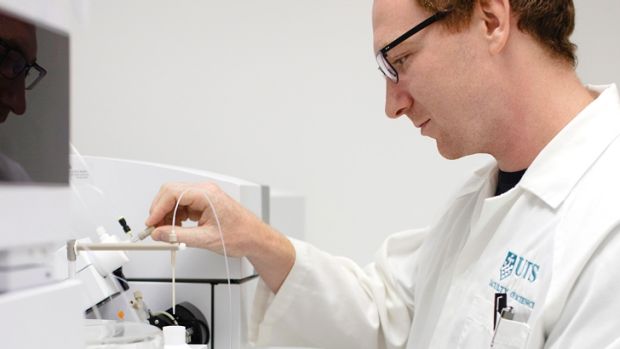
Dr Dominic Hare at work in his laboratory. Photo: George Ganio
Alzheimer’s disease is no respecter of fame or fortune. Former US president Ronald Reagan had it. Legendary AC/DC guitarist Malcolm Young has been diagnosed. Hazel Hawke suffered until her death in 2013. And author and broadcaster Anne Deveson is experiencing the distressing progression of Alzheimer’s, the most common form of dementia, a group of brain disorders affecting thinking and memory.
There is no way to spot Alzheimer’s early, no effective treatment and no known cure. However, a neurochemist at the University of Technology, Sydney (UTS), Dr Dominic Hare, and his colleagues are homing in on a biomarker, or disease indicator, to help diagnosis.
Moreover, Dr Hare – who is also with the Florey Institute of Neuroscience and Mental Health in Melbourne and the Icahn School of Medicine at Mount Sinai in New York City – says the team’s work promises to help reveal the cause of the baffling disorder.
“The disease develops so slowly and has so many effects on the body, being able to separate what’s cause and what’s effect is a big problem,” he says. “If we can identify why the disease is happening, we could intervene to alleviate the symptoms and potentially halt the disease process.”
At present, a diagnosis of Alzheimer’s disease is made only after careful clinical consultation, and any diagnosis can be confirmed only by examining the brain after death.
However, Dr Hare and his co-workers are not looking in the brain for clues. They’re looking in the blood. In a recent article in the US journal ACS Neuroscience, the group outlined its work with a potential biomarker and a possible causative culprit: iron.
“The body uses metals like copper, zinc and iron to facilitate biochemical reactions it wants. In the case of disease, these are reactions that are unwanted,” Dr Hare says, adding that iron plays a very important role in the ageing process, and ageing is the key risk factor for Alzheimer’s disease. One in four people over the age of 85 have dementia; 75 per cent of those have Alzheimer’s.
Professor Perminder Sachdev, co-director of the Centre for Healthy Brain Ageing at the University of NSW, says metals have previously been linked to Alzheimer’s but the findings were inconclusive.
“This study by Dr Hare and his colleagues is, therefore, of interest to researchers in the field,” says Professor Sachdev, chief medical adviser to Alzheimer’s Australia.
Specifically, Dr Hare’s team is studying transferrin, a protein that helps ferry iron around the body. In the case of Alzheimer’s, if transferrin falls down on the job iron may accumulate in the brain, where it contributes to the build-up of “plaques” and “tangles”. Plaques impede the transmission of signals among brain cells and tangles kill them.
To track transferrin’s activity, Dr Hare teamed up with Dr Blaine Roberts, head of the Metalloproteomics Laboratory at the Florey Institute. They designed the research using blood samples collected for the Australian Imaging, Biomarker & Lifestyle Flagship Study of Ageing (AIBL).
The multi-disciplinary, multi-institutional project is one of world’s largest studies of the biomarkers, cognitive characteristics and lifestyle factors implicated in Alzheimer’s.
“The unique thing about AIBL is that it’s following 1000 people through time,” Dr Hare says. “That gives us statistical power.” Participants provide blood samples and are tracked over 54 months.
Dr Hare, Dr Roberts and their colleagues used samples from 34 AIBL participants and 36 healthy participants. They employed specialised equipment to analyse samples: an inductively coupled plasma-mass spectrometer (ICP-MS), and a size exclusion chromatography-inductively coupled plasma-mass spectrometer (SEC-ICP-MS).
The results revealed, first, that compared to healthy volunteers, participants with Alzheimer’s had lower levels of iron in their plasma, a condition linked with anaemia of unknown cause.
Intriguingly, results from the ICP-MS and SEC-ICP-MS tests, showed healthy and Alzheimer’s participants had the same amount of transferrin in their blood but that the amount of iron carried by the transferrin was lower in Alzheimer’s samples. The implication: transferrin isn’t shuttling excess iron efficiently from the brain.
“The next step is to look at a copper-binding protein called ceruloplasmin that interacts with transferrin,” says Dr Hare. “Putting all these pieces together will help find methods to maintain quality of life, possibly slowing or even halting the progress of the disease.”
